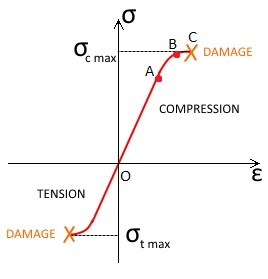strength - different brittle material law in failure model
Hello Colleagues !
I read:
HELP > RADIOSS > Reference guide > Starter Input > Materials > Failure models / Elasto-Plastic Material / Concrete and rock materials
RADIOSS THEORY MANUAL 14.0 ver. - July 2005 LD FEA PART 2
RADIOSS > Tutorial and Example > Examples47
I'm looking for the material law and failure model that would meet my needs:
1) my object - solid
2) my material - brittle elasto-plastic (without yield stress)
3) my material - strength-different (failure tensile stress = 40 MPa, failure compressive stress = 400 MPa)
4) my load - transverse bending
eg cast iron, silicified graphite, i.e material corresponding to the diagram in my picture.
In my opinion, the most suitable - LAW24 (concrete). It may be better to use another law ? What do you advise me?
But I do not fully understand LAW24 card.
p0 (density) - ok, i have
Ec - ok, i have
fc - failure compressive stress ? - if yes, ok, i have
ft - failure tensile stress ? - if yes, ok, i have
fb - biaxial compressive/tensile or bending stress ? I have failure bending stress = 100 MPa
f2 - what is it ?
S0 - what is it ?
Ht = -Ec - ok
Dsup - what is it ? (not use in Example47, value 0) - Do I need this?
epsmax - what is it ? (not use in Example47, value 0) - Do I need this?
Hv0 - what will this value give me? I don't have it. (not use in Example47, value 0)
And E , sigma_y , Et , alpha1 , alpha2 , alpha3 - for steel in concrete, don't need me.
Help me find the right law, please.
And help me understand and find all the parameters.
Find more posts tagged with
Hello @George P Johnson !
please go through /MAT/LAW27 in Help Menu
I already read a help about LAW27, but it's ONLY for Shells & Sandwich Shells and damage occur ONLY in tension.
My model - Solid.
My model should have two possible of failure: tensile & compressive, because I have bending load.
P.S. Сarbon steel (сast iron) also has a different tensile-compressive strength.
In the case of longitudinal bending, it is not known in advance what will occur before: compression failure or failure at stretching.
Yes @George P Johnson , I read this section, I indicated this in the first message.
RADIOSS > Tutorial and Example > Examples47
My question is: is this the only material law (LAW24) that is suitable for my task? This material law for iron-concrete.
1. Maybe there is a separate model of brittle fracture of tension-compression.
2. Or there are two models of brittle fracture: one for compression, another for stretching, and they can be used simultaneously.
And these models can be used in conjunction with the Johnson-Cook material law.
Really, to solve the problem of destroying any brittle material (cast iron, high-carbon steel, graphite, ceramics, glass etc.) with complex loading, there is only one way - to use a model of iron-concrete (LAW24) ??! =(


Hi Andrey,
f2 and S0 are concrete confined strength ratio and concrete confined stress ratio respectively. For a confined concrete behavior the strength and stress may vary from the traditional values and those we are specifying here. Dsup and Epsmax are damage/failure parameters. The material will fail when these parameters are reached.
Similarly other parameters mentioned are described in Help menu.
If you are looking only for a brittle material law, please go through /MAT/LAW27 in Help Menu, which is an elasto-plastic Johnson-Cook material model with an brittle failure model.